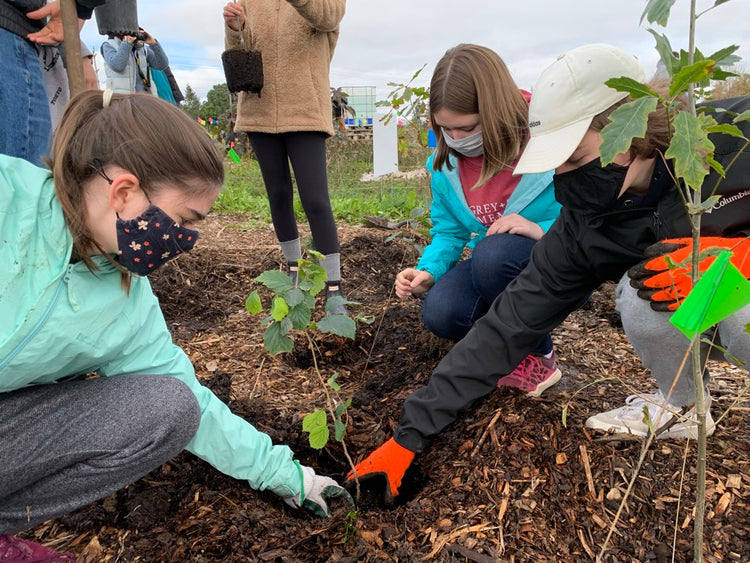Lakeside Community Garden, Kingston's largest community garden, was founded in 2012. It's located on two acres at the southwest corner of the Collins Bay/Frontenac Institution Prison Farm.
Our mission is to provide Kingston residents with space to share, learn, and grow. We believe that community gardening promotes strong community ties, ecological resilience through biodiversity, and awareness of the importance of a healthy and sustainable local food system.
In pursuit of this mission, we offer 92 vegetable allotment plots for a yearly fee of $30, free gardening space to diverse community groups, free plots to new Canadians, a large donation garden tended by St. Mary’s Cathedral (2000-3000 lbs of produce donated each year), a butterfly garden, and a seed saving garden managed by KASSI (Kingston Area Seed System Initiative). We host workshops for schools and the community.

Our design principles
- Cultivate relationships: By sharing our stories and shovels, our laughter and harvests, our gifts and our needs, we build relationships and weave community
- Serve as a learning lab: By following our curiosity, expanding our senses we can become a creative force for positive change
- Tune into the land: Plants aren't isolated entities, but participants in a system constantly in flux. Practicing intergenerational and multispecies seeing, sensing, and learning
- Grow resilience: By listening to, learning from, and adapting to the natural world we can strengthen the ecological web to which we belong
- Feed our spirits: along with the seeds we plant, we cultivate natural spaces that feed our spirits and strengthen our connection to and love for the land
- Strengthen community: grow connection and invite inclusiveness among a diversity of beings - people, plants, insects, microbes, birds, and animals
Why we planted a Little Forest, and why it's an edible Little Carolinian Nut Forest
- strengthen our community
- increase local food sovereignty
- help tree species migrate
- learn about the species Indigenous to this land
- grow our capacity to steward the land
- as a nature-based solution to the biodiversity and climate crises
We're combining what we’re learning about rapid natural forest regeneration from Western science with teachings from Traditional Ecological Knowledge (TEK) on how to transform our relationship with trees and with the land.
Our stewardship plan
Water: We have access to city through a tap at the adjacent Sharing Centre. We'll be hooking up hoses and sprinklers. We won't water on a schedule. Instead, we'll observe rainfall, observe the seedlings for water stress, and water if needed. We're also investigating digging a shallow pond on the North side of the Little Forest.
Protection from predation: We have little predation pressure at Lakeside, partially due to the number of Hawks, Owls, and Eagles that live in the nearby conservation area. No deer visit Lakeside. For the first two years, we will protect the saplings with white plastic spiral tree wraps supporting by flags.
Lakeside soil
Soil: Clay: details about soil (test results, drainage, texture, etc…, soil biodiversity?)
History of the land
Geology: TBI
Land use: Needs investigation. Conventionally farmed (tilled, pesticides, herbicides, monoculture crops) for around 40 years as part of the Collin's Bay Prison Farm. Likely once forested.
Preparing the soil
The Little Forest site has been sitting fallow for most of the time since becoming a community garden in 2012. Before site preparation began, the land was covered with mixed non-native pasture grasses, Goldenrods, Asters, and woody early successional species such as Silver Maple (Acer saccharinum), Green Ash (Fraxinus pennsylvanica), Red Osier Dogwood Cornus sericea, and Staghorn Sumac (Rhus typhina) were beginning to move in.
We chose a no-dig method of soil preparation, offering the soil microbiology an abundance of organic matter to help aerate the soil and shift from bacterial to fungal dominance.
Because of the timing of when we sourced the different materials, our woodchip layer was the first layer we applied on top of the existing vegetation, followed by garden debris, compost, and coffee grounds.
- 15cm woodchips
- 7cm leaves, grass clipping, and other garden debris
- 1.25cm AA leaf and yard waste compost
- sprinkling of coffee grounds
Lesson learned: We didn't begin with a layer of cardboard to smother the pasture grass, hoping that the thick layer of woodchips would be enough. Unfortunately, the pasture grass is so aggressive we need to remove or smother some of the pasture grass that managed to push through the layers of organic matter.

